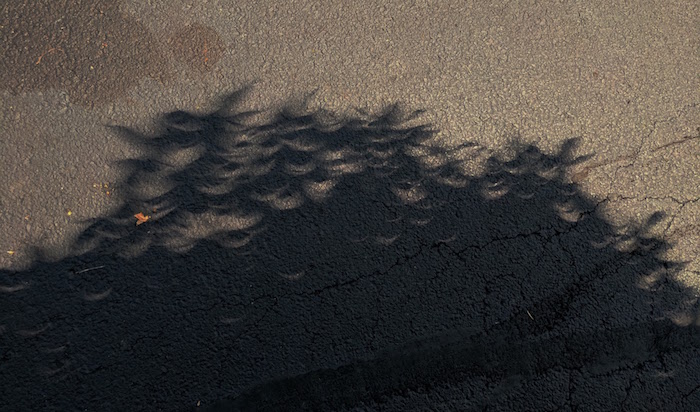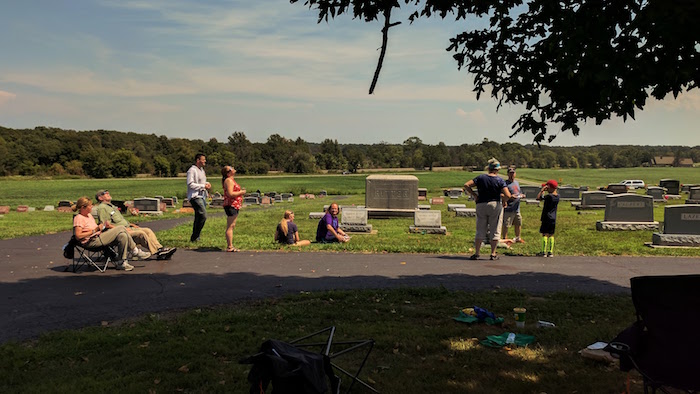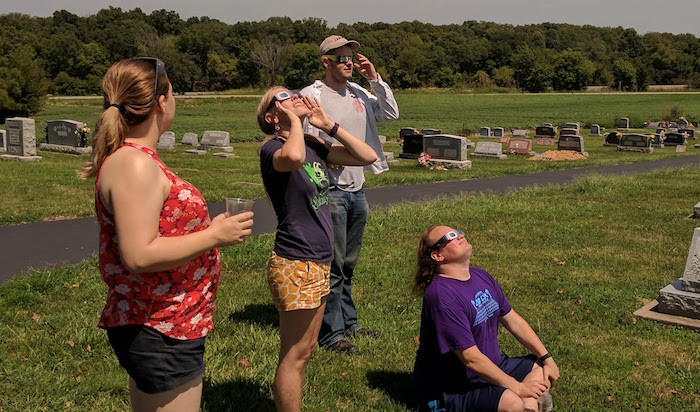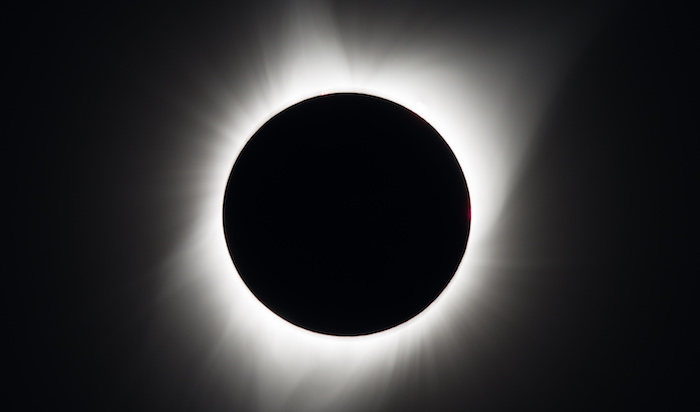Two years ago, on August 21, 2017, a total solar eclipse fell across a narrow band of mostly rural America, stretching diagonally across the United States from Oregon to Georgia. Folks said the Great American Eclipse would bring about the largest migration of people to see a natural phenomenon in history.
I witnessed the eclipse. Here’s what I saw.
There were endless lines of traffic flowing along the country roads towards the path of totality – or deeper into it, to view a longer eclipse. When the eclipse began – the first sliver taken out of the sun – the traffic just ended. There were still a few folks on the road, mostly locals who didn’t care enough about the eclipse to stop their business. But the endless lines of cars vanished. If you were in the path of totality and late to your preferred viewing spot, you pulled over to the side of the road and watched it from there.
You could only see the ever-growing bite taken out of the sun through eclipse glasses, a camera with a filter, a pinhole camera, or if you briefly glanced at the sun and looked away, perhaps blinking to see the afterimage seared into your retinas. If you just stared at the sun (which is both unwise and dangerous), the glare from it almost immediately overpowered the sun’s actual shape in your sight, causing it to appear more or less normal.
An odd property I wasn’t anticipating befell the shadows of trees. You know how the edges of the shadows of trees and branches are dappled? There are these overlapping circles of light that appear around their edges? Turns out that’s a camera obscura effect; it’s a projection of the sun passing through the tiny gaps between leaves. When the sun is being eclipsed, the dappling isn’t circular. It’s crescent-shaped – the exact shape of the visible sun at that moment. So if you stood in a dappled glade, the ground was covered with overlapping parallel crescents, all completely identical in shape and orientation. Lens flares, too, were crescents.

The sunlight grew fainter as the eclipse progressed. The effect was like boiling a frog, so slow you didn’t notice it until it was pointed out. But by 50% eclipse, it was darker outside, more like an overcast day, though we were standing in full and direct sunlight beneath a clear blue sky. The sunlight was merely not quite as bright as it should have been – though not by much, given that human perception of brightness is logarithmic, not linear. Similarly, the sunlight didn’t warm my skin with that pleasant searing sensation the way it should have on a clear summer day. It wasn’t cold – there simply wasn’t as clear a perceived temperature difference between full sun and shade.
By three-quarters progression (in most places, it was generally about an hour and a half from the start of the eclipse to totality, then the whole thing replayed backwards), the darkness ‘read’ as dim under a clear blue sky. It wasn’t like dusk, nor like twilight, more like the muggy, stifling haze that forms over the Arabian Gulf. The effect was deeply eerie.

Twenty minutes from totality, the light effect looked like a brighter version of day-for-night, the technique old movies used to film a shot during the day, then add filters to make it look like night. The technique never fooled anybody, but it was clear what they were trying to convey (“I know it looks weird, but let’s all pretend it’s nighttime, OK?”).
Fifteen minutes from totality, the headlights, running lights, and parking lights on cars were bright and attention-grabbing. Because our eyes were adjusting to the dimness but these fixed light sources weren’t, they appeared far brighter than they had any business being. The effect was distinctly different from anything you’d see at dusk, possibly because the color of the light was still a middle-of-the-day color, not the red light of sunset or the blue light of dusk. Bright colors started to look washed out. A field of wildflowers appeared wilted. The effect was eerie and remarkable.

Thirteen minutes out, the sun was a hangnail in the sky.
By twelve minutes out, the temperature had dropped perceptibly. It wasn’t chilly, just noticeably cooler than it was even half an hour ago. The light looked like someone had turned down the brightness and saturation in Photoshop.
By nine minutes out, the rate at which we perceived things growing dimmer was accelerating, as was the drop in temperature. It grew colder minute by minute. Had we been sweating earlier, it would have felt chilly.
At seven minutes out, the light looked like peering through the tinted windows of a car. It looked like lighting a dark interior space with artificial lighting.
At six minutes out, the sun was the thinnest sliver.

At three minutes out, set standard dim lights, like the tail lights on a parked car, were bright like neon signs in Hong Kong. The sun was so narrow it looked like a line drawn in mechanical pencil. Birds were confused, thinking it was night-time, and began to take flight.
At two minutes out, the sky in the direction from which the eclipse was approaching looked like a distant gray storm cloud, except there wasn’t a cloud in the sky. What should have been bright and blue was dark, for off in the distance there, totality had already hit. Crickets began to sing. The light acquired a faint reddish tint.
At one minute out, the horns of the sun began retracting inwards. Even now, the sun was too bright to stare at, too bright to see the effect without glasses. It grew darker and darker, like the heavens were about to open up in a thunderstorm. We could see distant lights on radio towers as if it were night. Lights we never would have noticed in a million years during the day were as obvious as the nose on your face. The experience was electric and ineffable. This was the first point where the transcription of my observations recorded me crying out “It’s the end of the world!”

When totality hit, the world fell apart. I can only give you the transcription of my babbling:
“The diamond ring is everything it’s been imagined to, to, to everything it’s been said to be! The light around the edge of the moon – The moon itself is a disc of black, a pure void, the light around the edge of it is, is incandescent, the pure white! You can see the stars, you can see the stars in the sky. It’s a sunset in every direction. A dim sunset, not a bright one, not a Florida gorgeous multicolored sunset, but it’s a sunset in every direction, and – oh my God – it’s the end of the world. It – it – it – it – it’s creation coming unmade. The edges of the light from the, the moon, from the sun coming around the moon are smears, like visual artifacts in a camera. It’s the end of a beautiful sunset, after the sun has dipped below the horizon. The fading light of day and aaaalllllll sun vanished on a normal sunset. And it’s unreal. You can see the ragged edge of the moon. You can see – and, and, and, and, now as the moon is starting to slide away, here comes the diamond ring again! It appeared as a flash of red (ed: later determined by examining photographs of the eclipse to be a solar prominence) and now it’s a diamond. You can see the corona around the edge of the moon. And now the diamond is growing in size, growing, and it’s devouring the moon, and you can see the visual artifact and light is coming back and it’s like bringing up the stage lights and light is flooding back into the world. And, and, and, and light – it’s merely dim again. It’s merely dim again.”

Once I calmed down in the minutes following totality, I noted that I really only saw one star, likely a planet. My friends claimed to see more, but I was in such a lather that I only saw the one. It was Mars, 19 degrees (two handspans) west of the sun. Venus was likely also visible 65 degrees west of the sun. Mercury and Jupiter were also up at the time, and possibly visible if you knew were to look – and were not busy being absolutely blown away by the eclipse.
One minute after totality, a nearby town started shooting off fireworks. Even though the stage lights had come back up (it was still absurdly dim, but nothing like the false night and susnet of a moment prior), the fireworks were visible in what was ostensibly broad daylight. Thanks to the odd quality of the light, it didn’t feel like we should have been able to see fireworks.
Two minutes after the eclipse, the birds were still flying, still confused about what had just happened.
Four minutes after totality, the sliver was drawn, again, with a mechanical pencil. Because of the contrast from the darkness of the eclipse, the dimness felt brighter than it did four minutes before totality. Everything was playing back precisely in reverse.
Five minutes after totality, the crickets shut off like someone flipping a light switch.
Seven minutes after totality, asphalt – which had been perceptibly cooler following the eclipse – was starting to warm up again.
Twenty minutes after the eclipse, there was traffic on the roads again. It wasn’t the endless lines of cars from before the eclipse, though the traffic was present in real numbers. There was a deadline to make the eclipse, but no deadline to depart afterwards. That said, traffic was backed up something fierce as all these folks got funneled down the handful of country roads that lead to interstate exits and the long highway home.
Before this event, I never understood at a gut level why people would travel around the world to see eclipses. I was sure they were cool, but was it worth spending thousands of dollars and traveling to the far side of the planet to experience a two-minute event?
It is.
I get it now. It’s the end of the world.
If you feature an eclipse at your table, I encourage to you to take advantage of its apocalyptic nature, especially in a fantasy game. People using eclipses for trickery is an old, old trope. But in a fantasy setting, it takes on a different character. Magic is real here, after all, and the gods are often vengeful. Maybe the villain isn’t lying when he says that the eclipse is a sign of the gods’ fury, and that doom can be avoided if you do exactly as he says.
Maybe a secret cult of star-worshippers has revealed itself to the duke. They say their god will destroy the world unless he gives them what they want right now. It’s an empty threat – until the light starts dim. They alone have predicted the eclipse. They killed the duke’s court scholar, the only one who might have heard of eclipses before. And since most folks don’t know about what happens at an eclipse besides the sun disappearing, the cult might fool not only the PCs, but also their players. Heck, since an eclipse takes about three hours from beginning to end (with about two minutes of totality at the hour and a half mark), you could even play this session out in real time.
–
Image credit: Daniel Schroeder, except the one of the sun being eclipsed, which is from NASA.






